Thomas Rainer: Interpreting nature
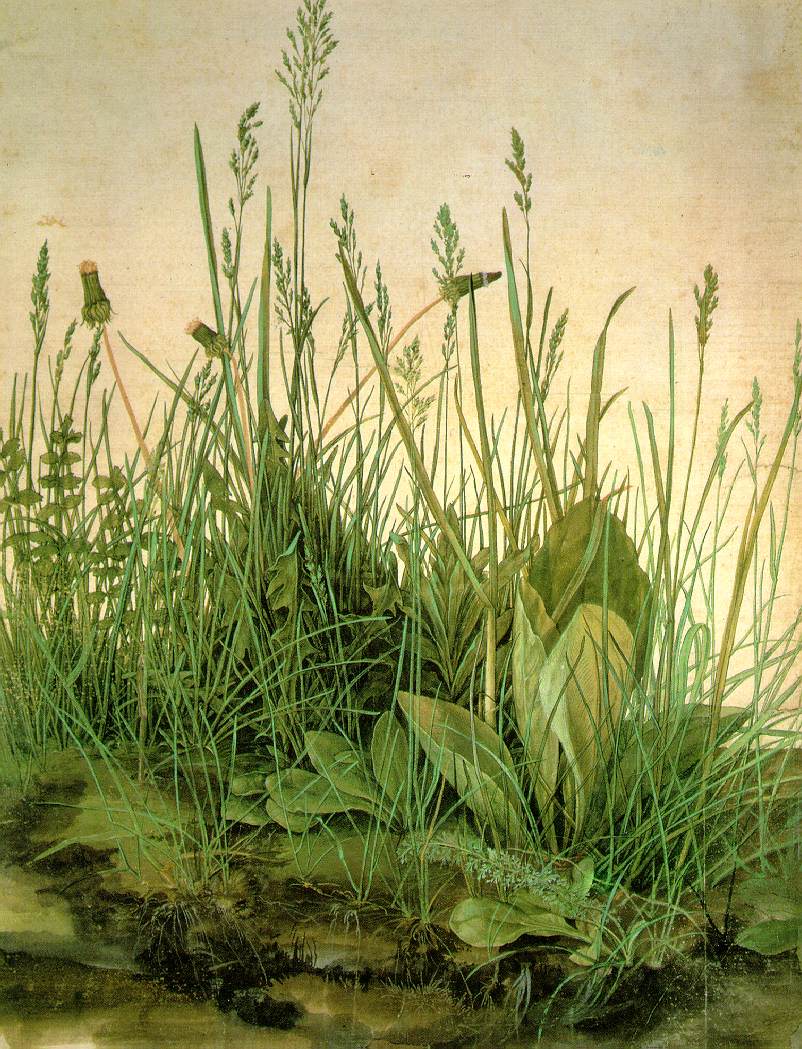 I'm too close to the subject of this post, so it hasn't come easily. My intent has been to write about Thomas Rainer's lecture at New York Botanical Garden in March, but I'm in such complete agreement with him, I find it hard to distinguish my own thoughts from my memory of Thomas's presentation. That said, I'll give this a try. I do hope I don't put any unattributable words in his mouth.The native plant movement has produced some extraordinarily beautiful landscapes ... and some appallingly ugly gardens. Many native-only gardens fail because they are created with too few plants, a lot of mulch, and abstract concepts of sustainability and conservation--all very unnatural conditions. Too often a native garden or a rain garden looks just the opposite of what it should be--a dry expanse of bark mulch punctuated by a few scattered plants struggling for life.Why do so many of these gardens look like this? Usually because the garden maker is following a recipe, and has not observed how plants grow in nature. Plants live in nature, not as individuals surrounded by empty space, but in communities--in dense, diverse, interwoven, thriving systems of living organisms that bridge the divide between life above ground and the less well understood, but extraordinarily complex, life below ground. Such plant communities, when not made exclusively of locally native species, could be described as artificial ecosystems. One proof that an artificial ecosystem is really an ecosystem is demonstrated by sustainable life over time. It's more successful if it provides other ecosystem services. If it, for example, attracts and satisfies bees and butterflies and other pollinators.The native plant movement in the US unfortunately has become highly politicized, and many discussions of native plants versus non-native ornamentals quickly degenerate into argument or name calling. The native plant movement has gained a reputation for saying "No" to many of the choices available to gardeners. It seems to have taken on the persona of a nagging, finger-wagging scold. Without change, the native movement is likely to continue along this negative track, alienating more people than it can attract with its message. It's too hard to do correctly, requires too much self-denial, and gives out personal rebuke to left and right. It says you are unethical, even immoral, if you don't grow natives exclusively.But there is another way. We can look at how plants actually grow in nature and adapt the natural growth patterns of plants, incorporating natives and non-natives into "natural" communities that grow like plants in the wild.But these are my words.Thomas Rainer addressed this subject much more systematically in his lecture--Designed Plant Communities--at the New York Botanical Garden last March. He spoke in NYBG's prestigious winter lecture series, in which such eminent practitioners as Tom Stuart-Smith and Kim Wilke have preceded him.
I'm too close to the subject of this post, so it hasn't come easily. My intent has been to write about Thomas Rainer's lecture at New York Botanical Garden in March, but I'm in such complete agreement with him, I find it hard to distinguish my own thoughts from my memory of Thomas's presentation. That said, I'll give this a try. I do hope I don't put any unattributable words in his mouth.The native plant movement has produced some extraordinarily beautiful landscapes ... and some appallingly ugly gardens. Many native-only gardens fail because they are created with too few plants, a lot of mulch, and abstract concepts of sustainability and conservation--all very unnatural conditions. Too often a native garden or a rain garden looks just the opposite of what it should be--a dry expanse of bark mulch punctuated by a few scattered plants struggling for life.Why do so many of these gardens look like this? Usually because the garden maker is following a recipe, and has not observed how plants grow in nature. Plants live in nature, not as individuals surrounded by empty space, but in communities--in dense, diverse, interwoven, thriving systems of living organisms that bridge the divide between life above ground and the less well understood, but extraordinarily complex, life below ground. Such plant communities, when not made exclusively of locally native species, could be described as artificial ecosystems. One proof that an artificial ecosystem is really an ecosystem is demonstrated by sustainable life over time. It's more successful if it provides other ecosystem services. If it, for example, attracts and satisfies bees and butterflies and other pollinators.The native plant movement in the US unfortunately has become highly politicized, and many discussions of native plants versus non-native ornamentals quickly degenerate into argument or name calling. The native plant movement has gained a reputation for saying "No" to many of the choices available to gardeners. It seems to have taken on the persona of a nagging, finger-wagging scold. Without change, the native movement is likely to continue along this negative track, alienating more people than it can attract with its message. It's too hard to do correctly, requires too much self-denial, and gives out personal rebuke to left and right. It says you are unethical, even immoral, if you don't grow natives exclusively.But there is another way. We can look at how plants actually grow in nature and adapt the natural growth patterns of plants, incorporating natives and non-natives into "natural" communities that grow like plants in the wild.But these are my words.Thomas Rainer addressed this subject much more systematically in his lecture--Designed Plant Communities--at the New York Botanical Garden last March. He spoke in NYBG's prestigious winter lecture series, in which such eminent practitioners as Tom Stuart-Smith and Kim Wilke have preceded him. His subject, as described by NYBG, was a critique of "native plant design approaches" and presentation of an alternative "bold, ecologically expressive design aesthetic that interprets rather than imitates nature." Thomas proposes we refocus the native plant movement toward designed plant communities, and he predicts a paradigm shift in the next decade from its current emphasis simply on use of native plants, regardless of design, to how plants exist in communities. For example, wild plant communities are characterized by a number of characteristics that make them both more sustainable and more attractive to look at--and designed gardens should do the same, because no one will take time to care for a garden (native or otherwise) if it doesn't stir the emotions, appeal in some way that moves the viewer. These characteristics are a balance of density and diversity, the ability to exist with little input, and a sense of harmony.Taking lessons from nature has a long history, going back to William Robinson in 19th and early 20th century England and even earlier. One of the important 20th century sources of this approach, one cited by Thomas, is Richard Hansen's and Fredrich Stahl's Perennials and their Garden Habitats (in the original German, Die Stauden und ihre Lebensbereiche published in 1981 and translated into English in 1991). This book, which presents hundreds of perennial species grouped by preferred habitat, has been extremely influential in development of the concept of the naturalistic garden over the past several decades. Based on many years of field research, it identified the importance of matching perennials with their preferred habitats, and introduced the concept of plant sociability--which plants grow well with other plants--in effect, furthering understanding of the concept and some of the mechanisms by which plant communities form and are sustained in gardened spaces.Thomas takes the "right plant, right place" advice of Hansen and Stahl, as elaborately extended into into detailed plant lists for specific plant habitats. They identify seven general habitats--woodland, woodland edge, open ground, rock garden, cultivated border, marshland and water's edge, and plants that grow in water. But that's only the tip of the iceberg. They break down each category into multiple subcategories, such as low, shade-tolerant perennials; tall-growing shade-tolerant perennials; shade-tolerant grasses and sedges; and so on for well over 300 pages. They also address plant sociability in some detail, providing lists of plants and how they should be placed, singly, or in groups and, if in groups, of what size.So "right plant, right place" is a gross oversimplification. The important point is that we should think of designing plant communities, not designing gardens of plants in isolation or grouped using only color or visual effect as the guide.Moving toward a step-by-step design approach, in his lecture Thomas suggested three principles for creating designed plant communities:
His subject, as described by NYBG, was a critique of "native plant design approaches" and presentation of an alternative "bold, ecologically expressive design aesthetic that interprets rather than imitates nature." Thomas proposes we refocus the native plant movement toward designed plant communities, and he predicts a paradigm shift in the next decade from its current emphasis simply on use of native plants, regardless of design, to how plants exist in communities. For example, wild plant communities are characterized by a number of characteristics that make them both more sustainable and more attractive to look at--and designed gardens should do the same, because no one will take time to care for a garden (native or otherwise) if it doesn't stir the emotions, appeal in some way that moves the viewer. These characteristics are a balance of density and diversity, the ability to exist with little input, and a sense of harmony.Taking lessons from nature has a long history, going back to William Robinson in 19th and early 20th century England and even earlier. One of the important 20th century sources of this approach, one cited by Thomas, is Richard Hansen's and Fredrich Stahl's Perennials and their Garden Habitats (in the original German, Die Stauden und ihre Lebensbereiche published in 1981 and translated into English in 1991). This book, which presents hundreds of perennial species grouped by preferred habitat, has been extremely influential in development of the concept of the naturalistic garden over the past several decades. Based on many years of field research, it identified the importance of matching perennials with their preferred habitats, and introduced the concept of plant sociability--which plants grow well with other plants--in effect, furthering understanding of the concept and some of the mechanisms by which plant communities form and are sustained in gardened spaces.Thomas takes the "right plant, right place" advice of Hansen and Stahl, as elaborately extended into into detailed plant lists for specific plant habitats. They identify seven general habitats--woodland, woodland edge, open ground, rock garden, cultivated border, marshland and water's edge, and plants that grow in water. But that's only the tip of the iceberg. They break down each category into multiple subcategories, such as low, shade-tolerant perennials; tall-growing shade-tolerant perennials; shade-tolerant grasses and sedges; and so on for well over 300 pages. They also address plant sociability in some detail, providing lists of plants and how they should be placed, singly, or in groups and, if in groups, of what size.So "right plant, right place" is a gross oversimplification. The important point is that we should think of designing plant communities, not designing gardens of plants in isolation or grouped using only color or visual effect as the guide.Moving toward a step-by-step design approach, in his lecture Thomas suggested three principles for creating designed plant communities:
- Create a palette from habitats similar to your site, using that habitat as the model for your garden.
- Vertically layer compatible species - The plants need to cover the ground. Except rarely, there will be no need for bark mulch, which inhibits the growth of plants, and prevents seeding and interweaving into viable communities. There should be a ground layer of long-lived, shade-tolerant species, a middle layer, and an upper layer, usually with transparent, leafless stems so plenty of light and air get through. The plants also must be compatible in terms of their environmental needs and sociability.
- Interpret and amplify - abstract the visual essence of native plant communities and amplify effects to achieve aesthetic aims.
The result of this approach to design of plant communities will be a work of artifice, most definitely not environmental restoration, yet also a living, self-sustaining community of plants. Within this realm, many aesthetic design options are available to the gardener. For example, use of a single, or a few dominant plants can give a garden a powerful feeling of calmness.To indicate designed intention in cities or suburban areas where the development of plant communities may violate planning or legal restrictions designed primarily to maintain neat lawns, a designer may also use orderly frames to contain wilder parts of the garden and to indicate design intent, much as mowing a simple path through a meadow can turn a "wild" meadow into a garden by redefining its conceptual framework.Thomas has recently been experimenting with designed plant communities in a suburban setting, at his own "ugly" (as he describes it) house in Arlington, Virginia. In such a context, the concept of framing becomes extremely important.Thomas was kind enough to send me some photos of the experimental plantings he's working with. In addition to being in a city environment, the house is at the intersection of several streets and has traffic on three sides. It's certainly a challenging site, one where you might think it would be very difficult to test out experimental planting communities."I'm sending you a handful of random images," he writes. "This is my border garden showing a fairly vertically layered planting (Nasella, salvia, nepeta). I'm not sure I'd call that a designed plant community because it is really not self-sustaining, but even that more horticultural planting is influenced by vertically layered wild plantings."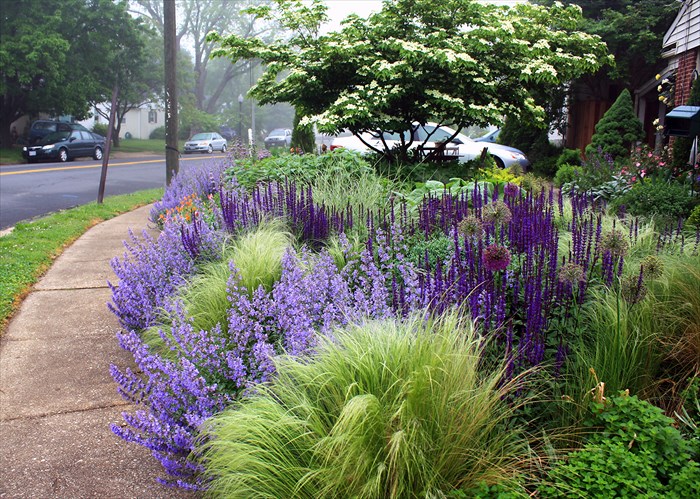 "The other set of images," he continues, "show the experiment on the corner of my yard where I'm doing a mix of planting quarts/plugs and a custom seed mix." Here is his design plan for the corner of the lot, right next to the sidewalk and street.
"The other set of images," he continues, "show the experiment on the corner of my yard where I'm doing a mix of planting quarts/plugs and a custom seed mix." Here is his design plan for the corner of the lot, right next to the sidewalk and street. "The strategy is to create a 'frame' around the edge with low massed perennials so that it looks somewhat ordered, but within that frame, a seed mix of low woodland edge natives was spread."And here you see a photo showing the Amsonia 'Blue Ice' ...
"The strategy is to create a 'frame' around the edge with low massed perennials so that it looks somewhat ordered, but within that frame, a seed mix of low woodland edge natives was spread."And here you see a photo showing the Amsonia 'Blue Ice' ...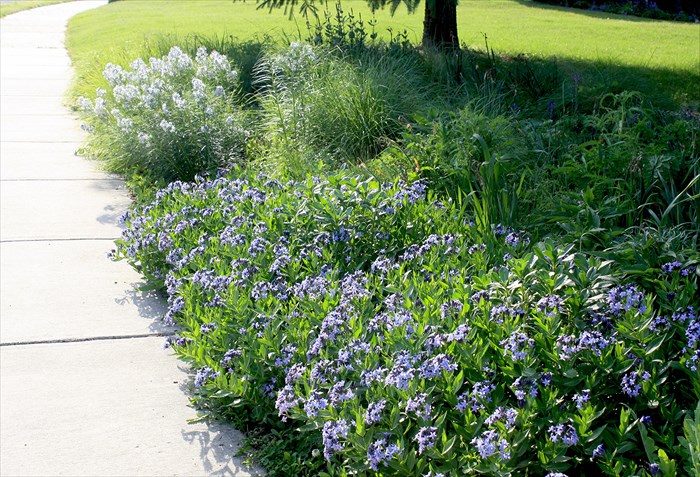 ... and the Sesleria indicated on the plan.
... and the Sesleria indicated on the plan. "This spring you can see all the sprouts coexisting with the young transplants," he explains. "It will take a few years to see how this turns out."
"This spring you can see all the sprouts coexisting with the young transplants," he explains. "It will take a few years to see how this turns out."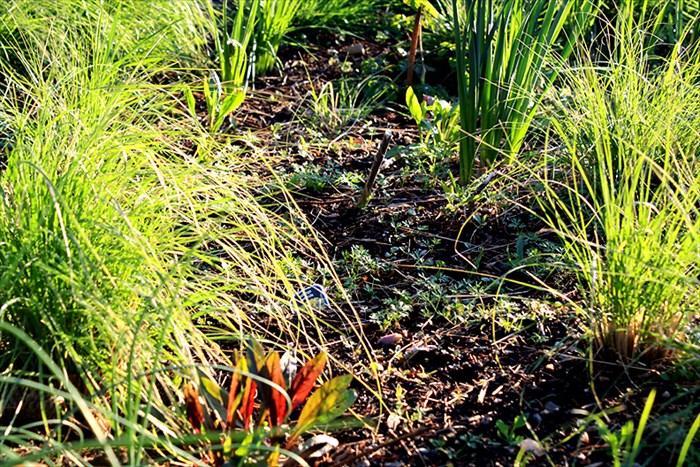
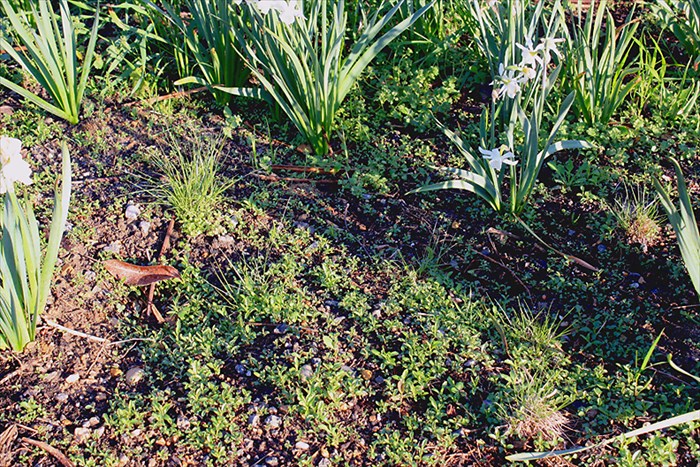 "This planting really is a designed plant community. I'll edit it, but essentially let it go to see what happens. The 'frame' and low height of all the species should help to make it more palatable in my urban/suburban context. Also I've been using bulbs (Narcissus 'Thalia', a glorious late blooming white daffodil, and Camassia quamash) and summer annuals to help this planting look a bit more ornamental until the seed mix fills in."The Durer water color that opened this post has long been my favorite botanical image. I thought it appropriate that Thomas used the same image to open his presentation. Durer's close observation of the vegetation growing on a clump of earth illustrates so well how plants grow in nature and, simultaneously, interpretes nature through artistic recreation.Thomas spoke for a solid two hours (with lots of visuals). Rarely have I sat through a lecture that long without finding my mind wandering, fidgeting, or myself wondering if I couldn't sneak out for a break. But this lecture was so filled with information and creative ideas, with humor, forthrightness, and a palpable honesty, he had my attention all the way. Thomas Rainer's well known blog is Grounded Design.
"This planting really is a designed plant community. I'll edit it, but essentially let it go to see what happens. The 'frame' and low height of all the species should help to make it more palatable in my urban/suburban context. Also I've been using bulbs (Narcissus 'Thalia', a glorious late blooming white daffodil, and Camassia quamash) and summer annuals to help this planting look a bit more ornamental until the seed mix fills in."The Durer water color that opened this post has long been my favorite botanical image. I thought it appropriate that Thomas used the same image to open his presentation. Durer's close observation of the vegetation growing on a clump of earth illustrates so well how plants grow in nature and, simultaneously, interpretes nature through artistic recreation.Thomas spoke for a solid two hours (with lots of visuals). Rarely have I sat through a lecture that long without finding my mind wandering, fidgeting, or myself wondering if I couldn't sneak out for a break. But this lecture was so filled with information and creative ideas, with humor, forthrightness, and a palpable honesty, he had my attention all the way. Thomas Rainer's well known blog is Grounded Design.